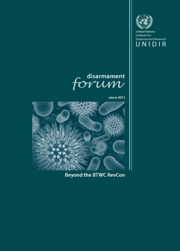The Convention on the Prohibition of the Development, Production and Stockpiling of Bacteriological (Biological) and Toxin Weapons and on their Destruction, more commonly known as the Biological and Toxin Weapons Convention (BTWC), entered into force on 26 March 1975. Although it is short—comprising of 15 articles—it opens with a clear message “never in any circumstances to develop, produce, stockpile or otherwise acquire or retain” these kinds of weapons.
Scientific and technological capabilities, together with the needs of society, have changed much over the last 36 years. The BTWC regime has responded to these changes by promoting wider stakeholder involvement and exchange, promoting education and encouraging innovation in the BTWC intersessional process. As the international community prepares for the Seventh BTWC Review Conference later this year, we have invited many of these stakeholders, including representatives from states parties, the convention's Implementation Support Unit, scientists, biological associations and the private sector, to reflect on passed and current activities and to voice their views of what could—or should—be done to further strengthen the regime.
Citation: Kerstin Vignard (ed.) (2011). "Disarmament Forum: Beyond the BTWC RevCon", UNIDIR, Geneva.
Disponible aussi en français.
Content
- Editor’s note, Kerstin Vignard
- Why the 2011 BTWC RevCon might not be business as usual - Piers Millett
- Bringing science to security: soft implementation of the BTWC - Kavita M. Berger and Neil Davison
- Biosafety professionals as stakeholders in the BTWC - Gary Burns, Karen Byers, Teck Mean Chua, Heather Sheeley and Brad Goble
- Verification for the BTWC: if not the protocol, then what? - Richard Lennane
- The 2007–2010 intersessional process and the future of the BTWC - Masood Khan, Georgi Avramchev, Marius Grinius and Pedro Oyarce
- UNIDIR focus
